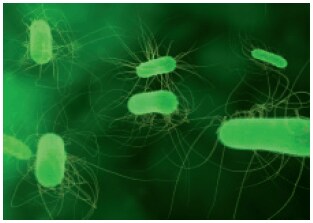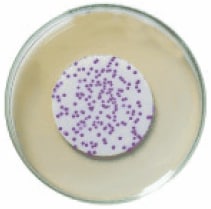Differentiation and Detection of Escherichia coli, Coliforms and Enterobacteriaceae
Jvo Siegrist
Analytix , Volume 8 Article 4
We offer a broad range of granulated, dehydrated culture media (DCM) in a variety of formulations for the enrichment, isolation and enumeration of E. coli, coliform bacteria and Enterobacteriaceae for food and beverage testing.
Our granulated media are not only convenient but also safe, and they meet the highest industry performance standards as described in ISO 11133. These media cause significantly less dust than powdered media, leading to less inhalation of hazardous media components that may cause allergic responses. In addition, they minimize contamination of the lab environment. In addition, our culture media for E. coli, coliforms and Enterobacteriaceae are quality controlled according to stringent standards.
Section Overview
Coliform Bacteria: The Broader Group of Indicators
Normal constituents of the intestinal flora of animals, coliforms are rod-shaped, Gram-negative, non-spore forming facultative anaerobes. They ferment lactose with the production of acid and gas when incubated at 35–37 °C. Although commonly found in lakes, rivers, swimming pools, and soil from faecal sources, in most cases coliforms do not cause illness. Since coliforms are easy to culture, they are used as indicators for other pathogenic organisms of faecal origin. The most common genera of coliforms are Citrobacter, Enterobacter, Escherichia, Klebsiella, and Serratia.
Enterobacteriaceae: The Most Well-Known Family of Bacteria
There are about 20 genera in the family Enterobacteriaceae, which include E. coli and the group of coliform bacteria. Members of the family are gram-negative and rod-shaped. They are facultative anaerobes that ferment sugar to produce lactic acid. Enterobacteriaceae are unable to form spores. Most species have flagella to move. Numerous Enterobacteriaceae are found in the intestines of humans and other animals, some occur in water or soil whereas others are parasites on animals and plants.
Most Enterobacteriaceae involve peritrichous type I fimbriae in the adhesion of the bacterial cells to their hosts. Some species produce endotoxins that are stored in the cells’ cytoplasm and released when the cells die, and the cell walls disintegrate. When many dead bacterial cells release their endotoxins into the blood stream, a so-called endotoxic shock may occur, which can be fatal.
Escherichia coli: Indicator Organism for Fecal Contamination

Figure 1.Escherichia coli
Escherichia coli (E. coli) is a gram-negative, facultative anaerobic, rod-shaped bacterium. E. coli are a large and diverse group of bacteria commonly found in the environment, food and intestines of humans and warm-blooded animals. Most strains of E. coli are harmless, they can even benefit their hosts by producing vitamin K2 and preventing pathogenic bacteria from establishing themselves within the intestine. However, some strains such as Shiga toxin-producing E. coli (STEC), can cause severe foodborne disease. E. coli and other coliforms are important indicator organisms to detect the presence of pathogens in food, occupational, and environmental safety applications, some of the most important areas of analytical microbiology.
E. coli (Figure 1) is the best-known coliform and an important indicator of faecal contamination because it is found almost exclusively in faeces. Occasional outbreaks of food poisoning have been linked to certain gastroenteritis-causing E. coli strains, such as serotype O157:H7. E coli are rod-shaped bacteria, distinguished from most other coliforms by their ability to ferment lactose at 44 °C, and by their growth characteristics on certain media.
Growth Culture Media for The Food and Beverage Testing

Figure 2.HiCrome™ M-TEC Agar for differentiation and enumeration of thermotolerant E.coli from water by membrane filtration technique. E.coli colonies appear blue because the chromogen, X-glucuronide, is cleaved by the enzyme β-glucuronidase.
Microbiological media is used not only to grow microorganisms, but also to select or identify a particular type of microorganism based on some unique or distinctive aspect of its biochemistry. Most of this so-called “selective growth” media contain a protein source, often a hydrolysate of casein, and a fermentable sugar, like lactose or glucose. Occasionally an indicator, like neutral red or bromo cresol purple, is added to detect the acid produced by the fermentation process.
A new generation of selective media is available from us that employs chromogenic and fluorogenic substrates (Figure 2). These media indicate E. coli by the presence of β-D-glucuronidase (GUD) and other coliforms by the presence of β-D-galactosidase. GUD catalyses the hydrolysis of β-D-glucopyranosiduronic acid into the corresponding aglycones and D-glucuronic acid. GUD is present in 94–96% of E. coli strains, but is also found in some Salmonella, Shigella and Yersinia spp.(1-3) There is a wide range of media available that use different substrates for the detection of E. coli and coliforms (Table 1). The media are also supplemented with agents like bile salts, brilliant green, sodium lauryl sulphate, and other substances to enhance their selectivity.
For a complete list of our growth and selective media, and our other products and resources for microbiology, please visit our website.
Table 1. Specific media for the detection, enumeration and identification of coliforms and E. coli
References
To continue reading please sign in or create an account.
Don't Have An Account?